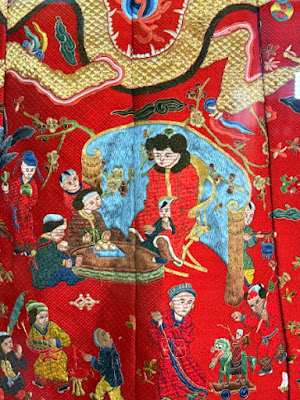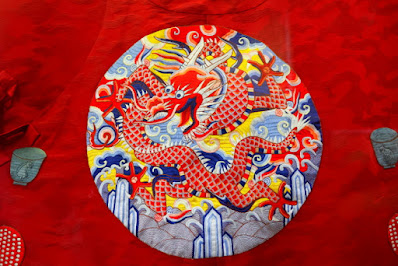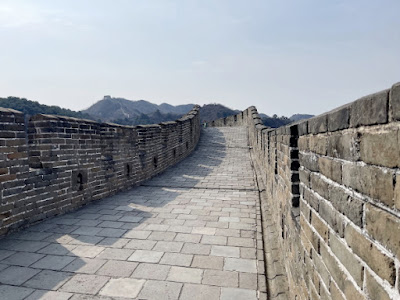 |
| Picture by Kolohe |
The Great Wall of China is 21,196 km (13,171 miles) long, so we had to pick one point that was open to the public and not too far away. Mutianyu, which is about 90 km (56 miles) north of Beijing, looked like an interesting point. Public transportation to Mutianyu was somewhat limited and time consuming, so we hired a guide named "Michelle" (English name) and car to drive us to the Wall. The Wall is a UNESCO World Heritage site.
Originally, the "wall" was a series of detached earthen ramparts that were built by individual states and cities for their own protection. Then, in 221 BC, Qin Shi Huangdi unified China under one rule and became the first emperor. After unification, the ramparts were never completely connected and only a few of the original earthen walls remain today.
The Ming dynasty (1368-1644) became the most prolific wall builders and they used better materials than the previous builders. New walls were built with kiln-fired bricks, cemented together with a mortar of lime and glutinous rice. The "walls" are actually two vertical walls about 7 m (23 ft) apart at the base, partially filled with large locally quarried rocks, overlaid with bigger rocks and stones, overlaid with tampered earth and rubble, then overlaid with stone slabs and bricks. Heights of the wall vary from 5-8 m (16-28 ft) and the carriageways are typically 4-5 m (13-16 ft) wide. Carriageway widths vary along the wall due to different landforms and military geographical locations. The widest carriageways are in Juyongguan, which have widths of about 16.7 m (54.8 ft) to accommodate military operations. In areas of rugged terrain, the carriageways were used to rapidly transport troops to other locations.
Watchtowers are located along the rampart "two arrow shots apart," which left no part of the wall unprotected. The watchtowers served as signal towers, forts, living quarters, and storerooms for provisions. Speedy communications along the wall used a combination of smoke flares, drums, and bells.
The section of the Wall we visited was constructed in 1368 and built on the foundation of an earlier wall built during the Northern Qi Dynasty. It was interesting to walk along the wall because it followed the highest points of the mountains' ridges to take advantage of the natural terrain for defensive purposes. From the wall there were great panoramic views of the surrounding areas.
Our tour book stated "Today, the defensive system of the Great Wall is generally recognized as one of the most impressive architectural feats in history...Apart from defense, other purposes of the Great Wall have included border controls, allowing the imposition of duties on goods transported along the Silk Road, regulation or encouragement of trade and the control of immigration and emigration."
 |
| Picture by Kolohe |
 |
| Picture by Kolohe |
 |
| Picture by Heather |
A chairlift carries visitors from the parking lot up the mountain to the base of the Wall. While riding the chairlift, my cellphone fell out of my pocket; but, fortunately, Sophia caught my phone before it fell to the ground. Without her quick actions, there would be a lot fewer pictures in my China blogs.
 |
| Picture by Kolohe |
 |
| Picture by Heather |
 |
| Picture by Heather |
 |
| Picture by Kolohe |
 |
| Picture by Heather |
 |
| Picture by Kolohe |
 |
| Picture by Kolohe |
 |
| Picture by Kolohe |
 |
| Picture by Kolohe |
Sophia said that she could "jump over the Great Wall," so I had to demonstrate that I was young enough to also "jump over the Great Wall." While I was jumping, my daughters noticed my watch and sunglasses and decided to give me a hard time.
Before we left for China, my watch broke and I did not have time to find a replace like the one I wanted with an expandable band, so I just went to Target and bought a $7.95 watch that snapped on my wrist. While I was there I noticed sunglasses were 75% off, so I also purchase a pair of sunglasses. While standing on the Wall, my daughters wanted to know why I had purchased a woman's bracelet watch and female sunglasses. I explained that at my age I did not know there was a difference between men's/women's watches and sunglasses and I just purchased the first thing that I could find that did not cost a lot of money.
 |
| Picture by Kolohe |
 |
| Picture by Kolohe |
 |
| Picture by Heather |
There were two little Chinese girls siting on the steps watching us because they thought we were a little crazy jumping up and down on the Wall.
 |
| Picture by Heather |
To get a better view of the wall, we walked between three different watchtowers. It was amazing to see the watchtower interiors and the type of construction they were using in 1368.
 |
| Picture by Kolohe |
 |
| Picture by Kolohe |
 |
| Picture by Heather |
 |
| Picture by Heather |
 |
| Picture by Kolohe |
 |
| Picture by Kolohe |
As we were getting ready to leave, we noticed an old yellow cat laying by the steps that led down from the Wall. Sophia started petting the cat when it woke up and then a young Chinese girl came over and quickly made friends with the cat. Soon we discovered another cat. The two cats seemed to be friends, so we decided to leave before anymore cats showed up.
 |
| Picture by Kolohe |
 |
| Picture by Kolohe |
 |
| Picture by Heather |
 |
| Picture by Heather |
 |
| Picture by Heather |
 |
| Picture by Kolohe |
 |
| Picture by Heather |
For an extra fee we were allowed to take a slideway back to the bottom of the hill. A sign warned that the slideway was dangerous and the chairlift was the recommended way down. We decided to take the slideway.
There were rubber pads under the carriage that people sat on and the pads were in down position when stopped. When a stick was pushed forward, the rubber pads lifted and the wheels could turn freely. The track was not banked for high speeds, so I had to lean way off of the carriage for tight turns. At one turn, a friendly worker kept waiving at me with a flag and shouting something in Chinese. I do not understand Chinese, so I just waived back.
 |
| Picture by Kolohe |
 |
| Picture by Kolohe |
 |
| Picture by Heather |
 |
| Picture by Heather |
 |
| Picture by Heather |
Of course, the ride ended in a small shopping area where part of the walkway was covered with beautiful Chinese decorated umbrellas. At one shop, Kolohe was fascinated by a man that carved Great Wall scenes on slate rocks. She ended up purchasing one of his rock carvings, which added to the weight of her already heavy suitcase on the way home.
 |
| Picture by Kolohe |
 |
| Picture by Kolohe |
 |
| Picture by Kolohe |
 |
| Picture by Heather |
 |
| Picture by Kolohe |
 |
| Picture by Kolohe |
 |
| Picture by Heather |
 |
| Picture by Kolohe |
 |
| Picture by Kolohe |
 |
| Picture by Kolohe |
 |
| Picture by Kolohe |
 |
| Picture by Kolohe |
 |
| Picture by Kolohe |
On the way back to Beijing we stopped by Ming Tombs, another UNESCO World Heritage Site. Of the 16 Ming emperors, 13 are entombed here.
Historic records indicate that the site was selected because of its fen shui location. There are mountains on three sides with an opening to the south that protects the dead from evil spirits that are carried on the north winds.
Ming Tombs reminded me of Valley of the Kings in Egypt, but it is much larger in land size and far less developed. The 13 tombs are spread out over 40 sq km (15.4 sq miles) and only one tomb has been opened. In the 1950s, the Ding Ling Tomb tomb was excavated and archeologist were amazed that his tomb was still sealed and the emperor's treasures were intact. Ding Ling (1573-1620) was the longest reigning Ming emperor.
We did not have the opportunity to visit Ding Ling's tomb, but we did visit Emperor Yongle's (1360-1424) tomb. Yongle's tomb is known in Chinese as Changling and was the first tomb built at this site. His burial chamber has never been excavated, but it is believed that the tomb contains Yongle, his wife, 16 concubines, and many personal artifacts.
 |
| Picture by Heather |
 |
| Picture by Heather |
After passing through the entrance building there was a courtyard that contained some really old trees, flowering plants, and the Stele Pavilion. The Stele Pavilion was built at a later date and contains writings from the Qing dynasty, which were revered the Ming emperors.
 |
| Picture by Heather |
 |
| Picture by Kolohe |
To reach the Hall of Eminent Favor, visitors must first pass through the Gate of Eminent Favor.
 |
| Picture by Kolohe |
The Hall of Eminent Favor is one of China's best preserved Ming buildings. It is a double-eaved building and constructed on a three-tiered terrace. Only the emperor was allowed to walk up the center ramp, which is now fenced to keep visitors from stepping on the ramp.
 |
| Picture by Kolohe |
 |
| Picture by Heather |
 |
| Picture by Kolohe |
 |
| Picture by Kolohe |
 |
| Picture by Heather |
 |
| Picture by Kolohe |
 |
| Picture by Kolohe |
 |
| Picture by Kolohe |
 |
| Picture by Kolohe |
The Hall of Eminent Favor's roof is supported by large 13 m (43 ft) tall cedar columns and the interior ceiling is highly decorated.
 |
| Picture by Heather |
We could not see the burial chamber because it is still sealed and under a large mound of dirt, but we were allowed to climb the Spirit Tower and take pictures. From the Spirit Tower, the roofs of other tombs were visible in the distance.
 |
| Picture by Kolohe |
 |
| Picture by Heather |
 |
| Picture by Heather |
 |
| Picture by Kolohe |
 |
| Picture by Kolohe |
 |
| Picture by Heather |
 |
| Picture by Heather |
 |
| Picture by Kolohe |
 |
| Picture by Kolohe |
Located just outside of Ming Tombs we found several souvenir shops and motor scooters with their protective covers.


















































































































No comments:
Post a Comment